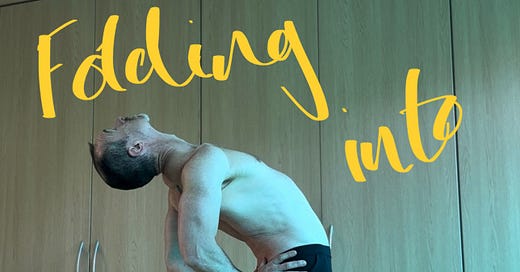Woah there, enough with the cryptic click bait Jon. Folding into unfolding?! Well, I am actually describing the process inside the backend. By ‘folding’ the inner spiral of the leg bones into the bowl and all of the structures your created in ‘thrust’, all of that energy and movement then pushes its way through the closed spaces on the inside of the spine, and in so doing unfolds us into openness. But before we get there, where were we?
The tortoise thrusts its way erect!
We make the journey from thrusting into our tortoise, to then thrusting our way back to semi-upright, only this time our arms continue reaching behind us. I ask you to keep reaching your arms behind you as this really seems to help me maintain the thrust of the movement in the thrust, so to speak, and we want this because it keeps our mind, awareness, and eventually breath all embedded inside our bowl. It also helps us maintain all five points (Yama as set out by Patanjali) of:
Our leg bones rolling out,
Our glutes firm and active,
Our ribs closed and sunk,
Our legs squeezed into our pelvic floor,
And our pelvic floor thrusting forward.
All of these points help create a solid, substantial, visceral feeling of connection within the body, all of it on the outside, meaning we can then begin to generate a contrasting feeling of space, softness, or release on the inside. This act gives us the ‘vessel’ (which coincidentally is the name of the composer and lead singer of Sleep Token), and we need a vessel within which we pour our attention, inviting Yoga to join us in the dance. So, the journey from folding to upright is an important one, one where you want to try and keep your body as ‘snug’ as possible so as not to allow any of the necessary tensions to leak.
When we find ourselves back in our thrust position, it is good to take a beat or two and observe how this posture differs from the first time you assumed it. This time around, assuming you’ve managed to contain yourself through the transitions, you’ll probably be feeling even more pulled into the floor, screwed via your horseshoes and compressed by the five Yamas above. This is so very, very important, I had to write ‘very’ twice to highlight it. It is important because without this tight and ‘snug’ structure, you’ll have nothing to “fold” into! And if you have nothing to fold into, then all of that amazing internal movement and energy simply leaks out from your bowl and therefore away from your spine into the surrounding fabric like going for a wee with your jeans on. Yes, I know this is crass, (plus it has made me laugh out loud), but in this obvious example, when you do not contain your internal energy, or move it through the correct pathways, you are just kind of pissing it away, so the analogy kind of works on that front. Anyway…
… the next move is so utterly simple, it is only surpassed in its simplicity by how easy it is to anything but. All you do is then spiral your leg-balls into their sockets. Yep, you reverse the direction of your leg bones whilst doing your very best to maintain the structure of ‘thrust’. The result is that this internal spiral has nowhere to go except up the spine, and due to the effort of holding the shape of thrust, it is directed up, bending you backwards. The beauty of this is found that the more you spiral in, the deeper you bend back, all the while your spine is being pulled more deeply into the support of the bowl and feels incredibly safe and natural.
It does this because you’re not actually trying to bend backwards. You are simply spiralling your leg bones into your bowl, which pulls the spine deeply down inside you, lengthening you eventually all the way up the inside.
When I perform this shape, I am very aware that the energy, contractions and effort of thrust are still present. It’s just that now, space presses up through the inside of my spine and opens my body, in the same way that a magician blows up a balloon to make a giraffe or a hat. I let the spiral ‘do me’! I allow the backbend to arise out from my bowl. I discover the posture from within, as opposed to trying to assume it from what I think it should look like. To state it again:
The posture happens when you simply reverse the spiral in the leg-balls. (But remember you have maintained the structure of ‘thrust’, so there is no chance of you collapsing back into your spine.)
Yet as simple as this is, it seems to be ten times easier to do anything else, or this along with lots of other things, or simply collapse back into your body because you forgot to maintain your structure. For instance, folk habitually initiate the back bend from their back as opposed to discovering the impulse to bend reaching up and out from their bowl. Or they spiral in whilst letting go of any of the physical connections they made in ‘thrust’, which means the only structure left to take the load is the spine, which is suboptimal to say the least. Or they end up lifting their chest/ribs, bending their knees, letting their legs rotate out or widening their stance in order to get into the shape of a deeper backbend.
I have no interest in flexibility!
In fact, on my recent trip to Lagos for my friend’s wedding, where I spent the weekend being asked: “So what do you do?”
Replying: “I teach yoga”
“Oh, I’m not very bendy…”
…only to then spend a short time explaining why yoga has little at all to do with flexibility and much more to do with our depth of connection. Granted, being flexible, mobile, nubile, feline, supple and all the other words to do with having healthy body and happy fabric, does seem to be a pleasant byproduct of the practice. Yet, yoga is an internal art, and I feel you can do all the bending you like, but unless it is leading you to direct energy through your central channel, I’m not sure if it is actually yoga that you’re doing. Now there’s nothing wrong with stretching if that’s your thing, I just really need you to know, that if you’re practising this practice, I prefer to see the tiniest of bending back, where it is coming from your bowl, rather than an overarching narrative of showing how far you can bend.
I’m not sure if you can tell, but there’s a lot I have to say on this, but another time, as for now, we need to talk about the head.
What should I do with my head?
This is a tricky question, as all too often our heads seem to be in the wrong space. I for one am only now beginning to appreciate how having your head screwed on correctly helps with everything from balance, coordination through to the quality of our thoughts and how we see the world. This makes the question of ‘what to do with your head’ in this back-bending shape an important question to ask and answer.
The simplest answer is nothing. Just focus on folding the inward spiral of your leg bones into the structure of your thrust. Even if this results in no noticeably movement of your head backwards, by prioritising pulling your spine deeply through your bowl into your horseshoes, you’ll keep your back safe, and since safely is the most important aspect of shape making, we should really stick with that.
However, if you do find yourself arching your way towards what’s behind you, then initially I’d say to draw your chin and gaze down to help extend the top of your spine. Gaining length from behind your heart to behind your ears is a great way to encourage that balloon of space to make its way higher up the inside of the spine. And after this, should you get there, then simply allow the base of your skull to slide up on your spine, so that your chin lifts without compromising the length in your neck. If you have the mobility in the fabric of your head and neck, you can then ‘hang’ the head looking back, which then acts like a weight to help draw the inside of the spine even longer. However, this is only worth trying once our foundations have made their way from the feet to the collar bones. If you don’t feel this, I’d recommend sticking with the basics and getting your roots deep and your foundations firm.
Even though I leave you here, I wouldn’t hang around in this shape for too long. However, how you choose to come out of it should you practice, I suggest it is gentle, easy and slow, followed by a rest. Maybe even coming to all fours to let your heart find the floor after that moment of sky gazing.
The video coming later in the week will have a suggestion on making your way out of the shape, so maybe wait until then if you’re cautiously curious. If you do give it a go and find this challenging, that’s great, because it wants to be, either due to you holding a structure, or challenging the stuck unnecessary tensions within that structure.
And I leave you with this… bending backwards is not about bending backwards! It is an opportunity to open the inside of your spine, which for some may well mean leaning back, whereas for others, it may just look like a very upright posture. Remember, Yoga is not the external shape but the internal reality of that shape.
🍵🍵🍵🍵





Hmmm..
I find it very difficult to fold in at that point. I realize I have hithero been doing it differently.
:thrusting/ folding out, all the way until somewhere in the backbend( the peak of it) it becomes a folding in and the Journey to get back begins..
I dont know how to get into the backbend now. Is it a thrust A N D a folding in at the same time?
A good challange tor me here a guesse!